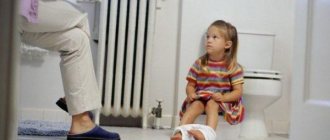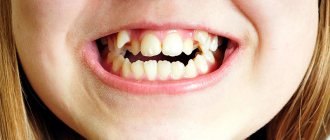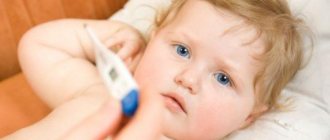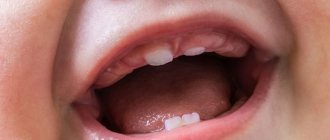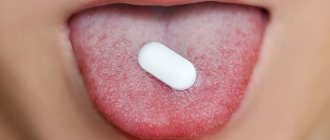Teething is an important event in the life of every child, because he will finally be able to taste solid food. However, the appearance of baby teeth is not always associated with joy and the arrival of the Tooth Fairy. Many children can become irritable and apathetic during the teething period. For some, vomiting, diarrhea, or fever occur when teeth appear.
Whether vomiting is actually caused by teething is controversial. There are no studies confirming the relationship between these natural processes. Most experts agree that teething may cause local pain, but not discomfort in other parts of the body such as rashes or diarrhea.
Other teething symptoms
Some children experience teething without any pain or discomfort. Others may exhibit specific symptoms:
- increased desire to chew;
- salivation;
- cry;
- irritability;
- inability to sleep;
- loss of appetite
- red, tender and swollen gums.
Parents’ concern for the baby’s condition is understandable, because they want to know exactly why the baby’s mood suddenly deteriorated or he began to be capricious.
According to the American Academy of Pediatrics, none of the following symptoms predict the onset of teething:
- cough;
- disturbed sleep;
- decreased appetite;
- vomit;
- diarrhea;
- rash;
- heat.
Belching - the mechanism of the process
Belching in a baby activates the process of digesting food.
Belching is a physiological process in which excess air is expelled from the stomach through the oral cavity. This requires a reflex contraction of the gastric muscles and an open cardiac sphincter. A person becomes familiar with this phenomenon in infancy.
During feeding, the baby swallows some air. It needs to be removed from their little tummy. But a small amount of air is necessary for the normal functioning of the gastrointestinal tract. This helps regulate internal pressure in the body. Additional functions of burping:
- Improving gastric motility
- Activates the process of food digestion
- Reduced pressure in the stomach
- A safe mechanism that prevents stretching of the walls of the stomach and intestines
During normal functioning of the gastrointestinal tract, the process of removing air goes unnoticed. But in pathological processes, additional symptoms are added to belching. In this case, additional examination and treatment of the underlying disease is required.
Why does a baby vomit when teething?
Teething is often wrongly blamed for many symptoms. However, research shows that cough, congestion, vomiting, diarrhea, rashes, fever (over 38°C) and sleep-wake problems are not symptoms of teething. In addition, scientists have found that no single set of symptoms can accurately signal the onset of teething.
The American Academy of Pediatrics explains that from the age of 6 months, a child's immune system weakens, losing maternal antibodies, which increases the risk of exposure to a wide range of diseases, including viruses and bacteria. This is why vomiting may have another cause, but not teething.
Belching in toddlers, which provokes a reaction
Belching occurs due to swallowing air while eating.
The normal amount of regurgitation in a toddler is 10 to 15 times a day. A larger number indicates the development of a pathological process. Additional factors that provoke belching:
- Increased activity during feeding or after eating.
- Tight swaddling, rompers or panties.
- Binge eating.
- Violation of feeding technique.
- Aerophagia is the swallowing of air while eating.
- Wrong combination when introducing complementary foods. For example, fruit puree after a cutlet.
- Dad or mom are smokers. The toddler inhales nicotine vapor. This helps weaken the stomach and sphincter muscles.
How to relieve teething discomfort?
To relieve gum discomfort, you can try massaging or rubbing them with your fingers, or giving your baby a chilled teething ring. If your baby is already chewing, you can offer him raw fruits and vegetables.
Do not give your child painkillers or gum rubs, such as viscous lidocaine or benzocaine. These medications may be harmful if swallowed. The US Food and Drug Administration opposes the use of these drugs due to the risk of overdose.
Overdose symptoms include:
- nervousness;
- confusion;
- vomiting;
- convulsions.
Aerophagia - causes and solutions to the problem
To prevent aerophagia, you need to monitor feeding techniques.
Swallowing air is common during feeding. The reasons for excess air ingress are as follows:
- The baby is worried and sucks greedily. At the same time, he opens his mouth wide. The reason may be a lack of milk from the mother or its complete absence.
- Mistakes during feeding. This happens with both breastfeeding and artificial feeding.
- Muscle weakness in a toddler due to problems during childbirth.
Prevention of aerophagia:
When to see a doctor
Teething can usually be managed at home. However, if a child has a high fever and symptoms not related to teeth, this is a reason to consult a doctor.
Some symptoms, such as vomiting, should not be attributed to teething because they may have a more serious underlying cause. Your doctor may want to run some tests to rule out other health problems.
On the Vikids platform you can:
When should you start worrying?
The baby's belching should stop before 7 months.
Up to 7 months – belching is considered normal for toddlers. By six months the number of episodes begins to decline. But there are situations when belching indicates pathological processes in the body. Signs of pathology:
- The baby begins to lose weight or does not gain it, and refuses to eat.
- Belching turns into vomiting. Green vomit is particularly dangerous due to the ingress of bile.
- Vomiting that is independent of food intake.
- The occurrence of spasmodic pain during belching.
- The toddler begins to cry, cough or gag during and after the air leaves the stomach.
- Belching with a putrid, pungent or unpleasant odor.
- Belching with traces of blood.
- Increased body temperature.
- Stopping the processes of urination and defecation.
Parents will not be able to solve this problem on their own. Be sure to consult a doctor if these symptoms appear.
Tips for parents
Let's figure out how to avoid possible dangers associated with regurgitation. The main thing that responsible parents need to know is that most often children burp while lying down. This position is dangerous due to aspiration (inhalation) of gastric contents.
Preventing aspiration is simple - just bring the baby upright or turn him on his side or stomach immediately after he burps. Then the baby will be able to push food out of his mouth.
It is worth remembering that it is unacceptable to leave a child with regurgitation syndrome without adult supervision, especially when lying on his back.
Child behavior
The mechanism of regurgitation is such that components of gastric juice enter the esophagus along with the food eaten. As you know, it has high acidity and irritates the esophageal mucosa. As a result, the child experiences discomfort and can become quite restless. It’s very easy to check whether your baby’s anxiety is related to regurgitation - just lay him on his back. If the problem is regurgitation, then the baby will behave even more restlessly. If not, then the horizontal position will not bring him discomfort.
If regurgitation occurs frequently, it is called regurgitation syndrome. It can lead to complications - chronic irritation of the respiratory tract. As a result of the constant aggressive effect of gastric juice on the mucous membranes of the upper respiratory tract, the latter are susceptible to an inflammatory process. Therefore, it is important to monitor the child’s condition and, if necessary, consult a doctor.
Danger signs
Responsible parents should be aware of dangerous symptoms that require consultation with a doctor:
- The baby is very restless and often turns around and arches his back when burping or feeding. This symptom may indicate chronic irritation of the esophagus.
- Regurgitation is frequent, abundant, observed after each feeding.
- The child is showing signs of dehydration.
- Regurgitation that first appeared after the first half of the year.
- Prolonged regurgitation without improvement (the same frequency and the same volume of regurgitation in a child 1 year and older).
- Regurgitation is accompanied by an increase in temperature.
- The child does not gain weight or even loses it.
- You cannot independently determine whether your baby is spitting up or vomiting.
There are even more dangerous symptoms, when they appear, you need to call an ambulance:
- The child stopped breathing after burping.
- A bluish tint appears on the lips and face.
- After regurgitation, the child lost consciousness.
- Reflux (stomach contents) that is green or brown can be a sign of intestinal obstruction or stomach bleeding.
Aspiration is extremely dangerous in infants who are unable to clear food from their airways on their own. The only thing parents can do is call an ambulance. It is not recommended to try to help your child on your own.
How to help a baby
If vomiting is accompanied by other symptoms characteristic of the appearance of baby teeth, there is no cause for concern. It is recommended to consult your pediatrician regarding this issue.
It is difficult to prevent the development of gag reflexes , but parents are able to make their baby feel better by:
- massage the gums in the places where the molars erupt. Massage the gums with bare fingers. Any pressure should be avoided;
- the use of special teethers, which can be found in a baby goods store. These devices eliminate itching and discomfort in the gum area;
- treating gums with gels that have an anesthetic effect (Dentol - available at the pharmacy without a prescription);
- timely elimination of saliva, which is abundantly released during the teething of the incisors.
Parents should not insist on their baby eating large amounts of food, which can cause vomiting.
Give food in small portions, after thoroughly grinding it.
Where does the rubella rash appear first in children? How to distinguish it from prickly heat? Let's ask the doctor!
What are the symptoms and treatment of scarlet fever in children? Our article will talk about this.
You can learn about the treatment of bacterial stomatitis in children from this publication.
Probable Causes
Food intoxication can lead to pathological belching.
Doctors identify several probable causes for the development of pathological belching. All diseases require the attention of a doctor and careful treatment. Belching as a sign of disease:
- Hydrocephalus is the accumulation of fluid in the structures of the brain. It can be congenital or acquired. The first is a consequence of some viral diseases suffered by the mother while waiting for the toddler. The second is a consequence of a difficult birth, head injury, meningitis at an early age.
- Perinatal encephalopathy is a pathological process in the brain of a toddler that develops in 1 month of life. There can be a lot of reasons. These include maternal illnesses, unfavorable working conditions, stress, infections, childbirth before the age of 18, Rhesus conflict, and pathological childbirth. Each case is individual.
- Achalasia is a disorder of motor activity of the esophagus. Although this disorder belongs to gastrointestinal diseases, it is, in fact, a neurological disorder. The reasons for the development of this pathology are unknown.
- Pyloric stenosis is a congenital pathology of the pylorus of the stomach. Boys get sick more often than girls. Acquired forms are extremely rare as a result of a previous stomach ulcer. Doctors identify the following possible causes of the disease: the effect of certain medications, exposure to toxic reagents in early pregnancy, and endocrinological disorders. The result may be intestinal obstruction.
- Food intoxication.
- Infectious diseases.
- In rare cases of kidney disease.
All these pathological conditions require the attention of a doctor. Self-treatment in this case is not only inappropriate, but also dangerous. In difficult cases, surgery will be required. But only after consultation with a gastroenterologist, surgeon and based on the results of a thorough study.
Parents! Don't panic! Surgical actions for pyloric stenosis and achalasia are carried out according to methods proven over the years. Usually it is allowed to start feeding a toddler already on the 1st day after the intervention. In order to reduce the risk of developing pathologies, the expectant mother should undergo all the necessary tests and behave according to the recommendations of the gynecologist. If additional symptoms appear, do not self-medicate. Show your little one to the doctor! It's better to be safe than to bite your elbows later!
Treatment
Treatment is required if respiratory complications occur or if irritation of the esophageal mucosa is suspected. In this case, the specialist will prescribe medications that reduce the acidity of gastric contents. This will not help with regurgitation, but will prevent further trauma to the esophagus. Specific medications are selected individually at an appointment with a pediatrician.
If the cause of regurgitation is an anatomical defect, surgical treatment may be required. Indications for surgery and its scope are specified by the surgeon.
For advice on infant feeding, please contact the specialists at the CELT clinic. Extensive experience, highly qualified clinic doctors and modern equipment are the key to the health and successful development of your children.
Make an appointment through the application or by calling +7 +7 We work every day:
- Monday—Friday: 8.00—20.00
- Saturday: 8.00–18.00
- Sunday is a day off
The nearest metro and MCC stations to the clinic:
- Highway of Enthusiasts or Perovo
- Partisan
- Enthusiast Highway
Driving directions
How teeth are cut: the order in which they appear
Every adult can understand how a baby feels when his first teeth are cut - just remember how the so-called “wisdom teeth” appeared.
Swelling of the gums, itching and pain - you must admit, this is not pleasant. Therefore, infants often become capricious during the teething process. They may lose appetite and sleep, and even have a slight rise in temperature. The earliest time for baby teeth to erupt is at the incisors (front teeth). There are four of them on each jaw. As a rule, the lower two incisors erupt first (at 6-8 months), then the upper central incisors. The teeth appear in pairs opposite to each other, this is important for the formation of a correct primary bite. At 8-12 months, the baby develops lateral incisors (first on the lower jaw, then on the upper). At one year old, a child should have eight teeth. After this there is a short break in their appearance.
Next in the sequence are fangs. There are two of them on each jaw. The location and structure of these teeth makes their eruption especially difficult and difficult for the child. At the age of 16-20 months, fangs will appear on the lower jaw, and then on the upper jaw. Then comes the turn of the painters (large molars). They begin to erupt at 20-30 months, each child at its own time. There are a total of 20 teeth in the primary occlusion, 10 on each jaw: 4 incisors, 2 canines and 4 painters. All of them should appear by 2.5-3 years.
Vomiting or regurgitation?
In infants, vomiting should be distinguished from regurgitation. With regurgitation, as with vomiting, the contents of the stomach return to the mouth. However, this happens once, immediately after eating. The reason is overfeeding or swallowed air. The air exits back through the esophagus; a slight tension of the abdominal muscles is enough for this. This fundamentally distinguishes regurgitation from vomiting spasms, in which both the abdominal muscles and the diaphragm are involved. When vomiting, the child behaves restlessly, turns red from overexertion, and after an attack he feels weakened.



